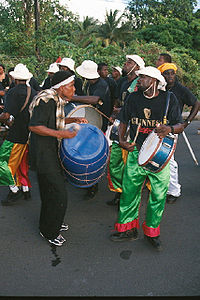- Culture of Dominica
-
Contents
Dominica is home to a wide range of people. Although it was historically occupied by several native tribes, the Arawaks and Kalinago Carib tribes remained by the time European settlers reached the island. 'Massacre' is a name of a river dedicated to the murders of the Native villagers by French and British settlers, because the river ran red with blood for days. Each (French and British) claimed the island and imported slaves from Africa. The remaining Caribs now live on a 3,700-acre (15 km2) Carib Territory on the east coast of the island. They elect their own chief.
Dominica is often seen as a society that is migrating from collectivism to that of individualism. The economy is a developing one that previously depended on agriculture. Signs of collectivism are evident in the small towns and villages which are spread across the island.
Dominican cuisine is similar to that of other Caribbean countries. Common main courses comprise meat (usually chicken, but can be goat, lamb, or beef) covered in sauce. The sauces are either spicy pepper sauces, or concoctions made from local fruit. A huge variety of local fruit, from tamarind to passion fruit, are served on the island, usually in juice or sauce form. Soursop is peeled and eaten raw. Sorrel, a red flower that only blooms around Christmas, is boiled into a bright red drink.
The National Psyche
Dominica draws on a mix of cultures: French place names feature as often as English; African language, foods and customs mingle with European traditions as part of the island's Creole culture; and the Caribs still carve dugouts (canoes), build houses on stilts and weave distinctive basketwork. Rastafarian and Black pride influences are also common. The Bahá'í Faith in Dominica is about 1% of the population.[1][2]
With an almost 80% Roman Catholic population, conservative traditional values are strong. Family holds an important place in Dominican society, so much so that a government poster warning Dominicans of the dangers of transporting illegal drugs lists separation from family (followed by imprisonment and loss of life) as the number one deterrent to the crime.
Amerindians
The first settlers on the island arrived to the Commonwealth of Dominica about 400 BC, when the Arawaks, a group of peaceful hunter-gatherers, established villages after island-hopping across the Eastern-Caribbean. The more aggressive hunter-gatherers, the Carib Indians (both descendants of the Ciboney tribe), annihilated the Arawaks and took hold of the island. Most native Caribbean people on other Caribbean islands were mostly killed by European colonists. The local Dominican Caribbean natives were able to hide in areas which were hard for European soldiers to find. The English Queen granted a 3,700-acre (15 km2) territory in east coast of Dominica for the native Caribbeans in 1903. Today, there are only 3000 Caribs remaining after years of brutal treatment by the Spanish, French and English. They live in eight villages, and they elect their own chief.
On the east side of the island, the descendants of the Carib Indians continued to practise their time-honoured culture and crafts of canoe building and basket weaving. Their society, however, has developed and modernised. The Amerindians' influence remains on the island through their artifacts and the sounds of modern language. For example the word hurricane originated from the Amerindian word huracan.
Other Settlers
When Christopher Columbus passed by the island he did give Dominica its name, but left no other settlers on the island. It would be years before English and French settlers came to the island. These two European superpowers fought relentlessly for the island, and their cultures each took hold. However, African slaves have also left an indelible mark on the island.
French influences include the island's native language, a creole, food, and many location names. The British government won the island, and the influences of government as well as the official language are distinctly theirs. Africans also influenced the creole and food, as well as the distinctive local style of dress.
Carnival


Each year, Dominicans celebrate the Catholic Carnival, a festival held for three days before Ash Wednesday. Due to the country's French heritage, a majority of citizens are Catholic, but many non-Catholics also celebrate Carnival. Activities include the Calypso Monarch Competition, Carnival Queen Pageant, and Carnival parades and parties.
Music
Music and dance are important facets of Dominica's culture. The annual independence celebrations show an outburst of traditional song and dance preceded since 1997 by weeks of Creole expressions such as "Creole in the Park" and the "World Creole Music Festival". Dominica gained prominence on the international music stage when in 1973, Gordon Henderson founded the group Exile One and an original musical genre which he coined "Cadence-lypso" which paved the way for modern Creole music.
The 11th annual World Creole Music Festival was the first activity held there since its completion on October 27, 2007, part of the island's celebration of independence from Great Britain on November 3. A year-long reunion celebration began in January 2008 marking 30 years of independence.
See also
- Religion in Dominica
External links
References
- ^ Bureau of Democracy, Human Rights, and Labor (2007-09-14). "International Religious Freedom Report - Dominica". United States State Department. http://www.state.gov/g/drl/rls/irf/2007/90250.htm. Retrieved 2008-12-03.
- ^ "International > Regions > Caribbean > Dominica > Religious Adherents". thearda.com. thearda.com. 2001. http://www.thearda.com/internationaldata/countries/Country_69_2.asp. Retrieved 2008-12-04.
Categories:- Dominica culture
Wikimedia Foundation. 2010.

